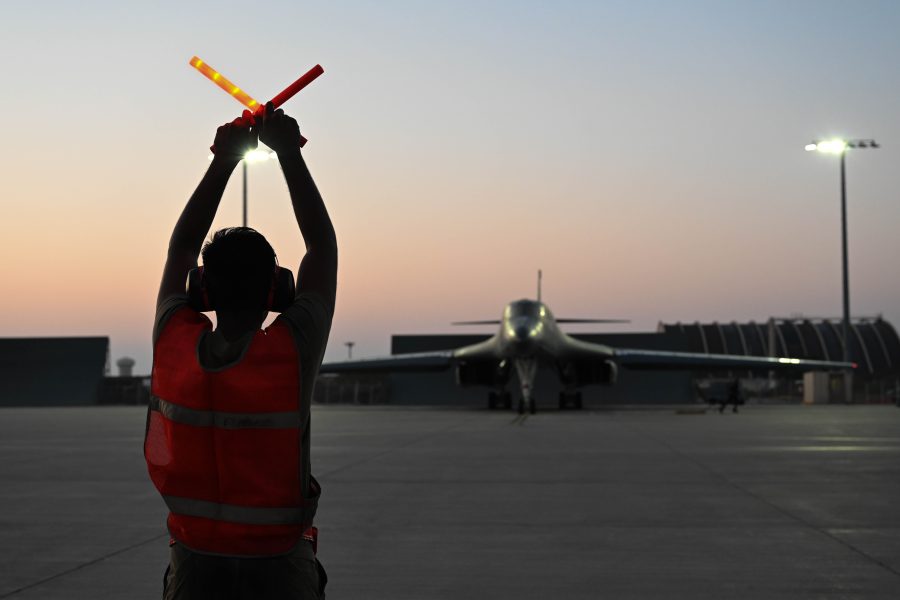As investigators probe the wreckage of a B-1 bomber that crashed while landing at Ellsworth Air Force Base, S.D., on Jan. 4, the runway will remain closed until at least Jan. 19, according to a Notice to Airmen. Ellsworth itself is restricted to visitors on “official business only,” the notice said.
A team of investigators, including personnel from the B-1 depot at Tinker Air Force Base, Okla., are conducting a safety investigation to see if there is any immediate mechanical or procedural reason to ground the entire B-1 fleet. While B-1 operations at Ellsworth have been halted, operations continue at Dyess Air Force Base, Texas—the other main B-1 base—and other bombers are available at Edwards Air Force Base, Calif., for test operations.
Service officials said it will take until at least Jan. 19 to fully document the crash site and move the carcass to a hangar, where further investigation can continue. During that same time, the runway manager will conduct a sweep of the airfield for debris needed for the investigation and to clear any potential foreign objects that could threaten future flight operations.
A Global Strike Command spokesperson said an accident investigation board chairman has been selected but that officer’s name has not yet been announced.
The accident investigation board is a longer process that can take many months to discover the root cause or causes of a Class A mishap. A Class A is any accident that involves loss of life, severe injury, loss of an aircraft, or other damage totaling more than $2.5 million. Such an investigation probes crew actions, health, rest and training; the aircraft’s maintenance history; weather conditions; and other salient factors.
Weather conditions at the time of the accident were poor, with below-freezing temperatures and fog in the area. The mishap aircraft was the second in a two-ship formation returning from a training flight; the lead aircraft landed without incident.
It has not been determined yet whether the aircraft is a total loss, according to the Global Strike Command spokesperson, who could only say that the mishap aircraft is “not airworthy.”
Unofficial and unconfirmed imagery circulating on Facebook pages and other social media show a B-1 covered with snow or foam that has been severely burned and bent in a catastrophic manner in a grassy area off a runway. In one image, the B-1, photographed from behind, is resting on its engines and missing its tailcone, with its left elevator badly bent. Additionally, the flaps on the swept-forward wings appear to be skeletonized, likely from fire.
Another image attributed to a NewsCenter 1 webcam shows the aircraft severely damaged from just forward of the wing roots to the nose.
Satellite imagery of Ellsworth dated Jan. 6—taken by Planet Labs and shared with The War Zone—shows that the aircraft struck the ground beyond the overrun of runway 31/13, and after briefly staying on the centerline, veered left off the main runway and came to rest in the grassy area between the runway and the taxiway, leaving a heavy black trail in its wake.
The four crew members ejected successfully from the aircraft. Three were treated at base facilities and one at a nearby hospital. All are expected to make a full recovery.
The AFGSC spokesperson said it has not yet been determined if the Air Force will attempt to replace the mishap aircraft by resurrecting one from the “Boneyard” at Davis-Monthan Air Force Base, Ariz. That determination may have to wait until the Accident Investigation Board (AIB) makes its final report. The Air Force is authorized to operate 45 B-1Bs, but now has only 44.
The Air Force persuaded Congress in 2020 to permit the service to reduce B-1B fleet from 62 to 45 airframes—but keep the same level of maintenance funding and personnel—in order to improve the mission capability levels of the type, which had been struggling to meet USAF standards after the B-1Bs flew extended duty in Afghanistan and Iraq, incurring heavy structural fatigue.
The Air Force justified the divestiture by saying, in part, that the B-1s identified for retirement would cost from $10 million to $30 million each to restore to full mission capability.
The last of the 17 B-1s retired in the divestiture went to Davis-Monthan in September 2021.
After the retirements, the remaining operational B-1 fleet saw an uptick in mission capability rates, with more spare parts and maintenance crews available for each one.
It’s not clear whether the aircraft sent to Davis-Monthan were put into recallable—or “inviolate”—storage, or whether they have been used for cannibalization purposes.
Since 2012, the Air Force has been running an extended structural fatigue test on a B-1B wing and fuselage, “aging” the items with pulleys and bars to simulate years of flying. The service reported in 2021 that its goal is to accumulate 28,000 simulated flight hours on the wing and 27,000 hours on the fuselage, but it was at that time behind schedule, and had only “aged” the two test articles to about 16,000 hours on the wing and 7,200 hours on the fuselage. The tests are also paused from time to time to make changes and modifications to the test articles so they are representative of operational aircraft, which occasionally have stiffeners or other structural enhancements applied.
In 2021, the B-1 fleet averaged about 12,000 hours of flying time.
